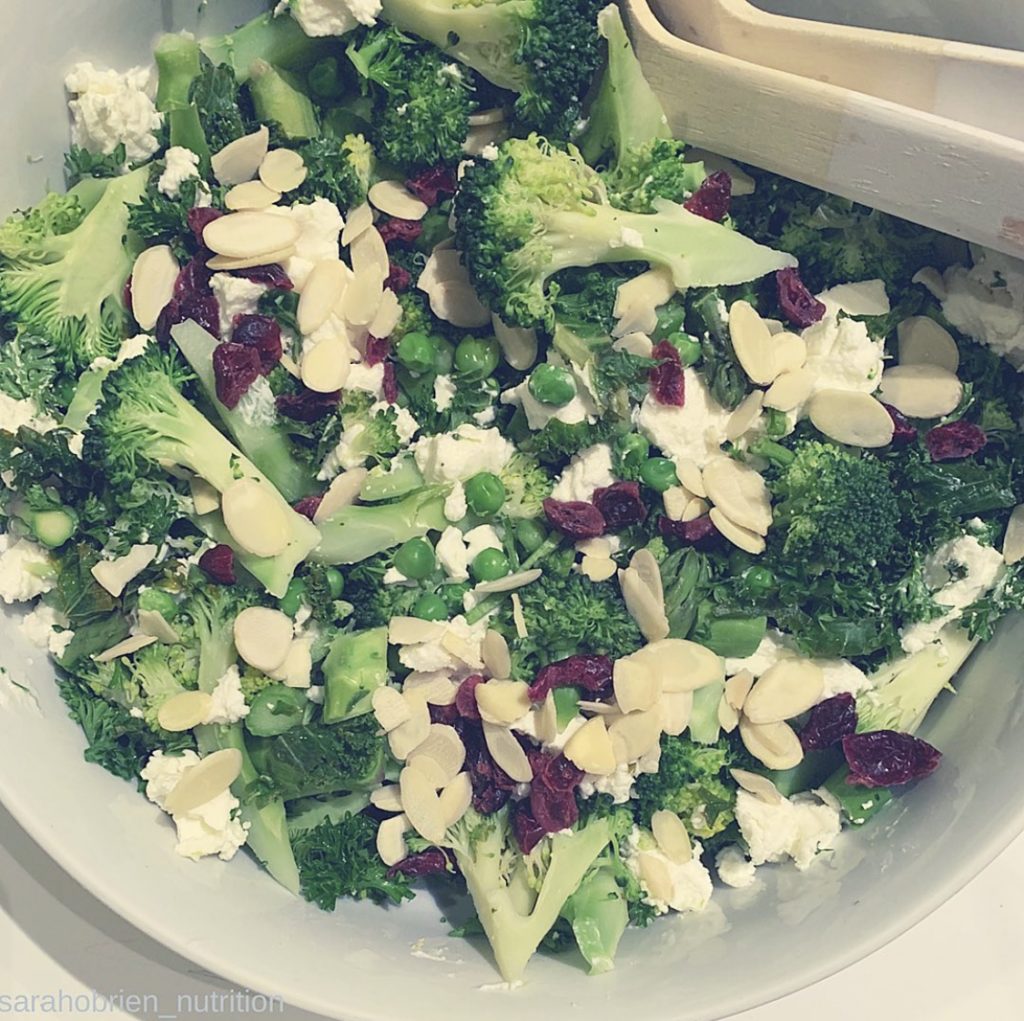Green goodness salad + a bit about cruciferous vegetables

This simple and nourishing salad packs a nutritious punch and makes a fabulous side dish, or, paired with some protein, can be the main event – it is quick to make and is full of subtle flavors and texture…
All of the ingredients in this dish have their own stories to tell from a nutritional standpoint, but today I’d like to focus a little on it’s cruciferous vegetable heroes, broccoli and kale – including these foods as part of your weekly meals is easy and can play a supportive role in your overall health and wellbeing ~ a bit more about these nutritional powerhouses can be found after the recipe below.
I would, however, like to encourage you not to focus too much on specific foods – aiming to include cruciferous vegetables a few times a week is great. I am a big advocate of eating a wide variety of foods as part of a balanced diet; this helps us get a range of nutrients that work in lots of different ways without us really thinking too much, or stressing, about it. Of course, there are times when we may need to focus more on our intake of specific foods and nutrients such as during times of illness, particular stress or pregnancy or if a notable gap is shown during a dietary analysis, for example.
Back to the recipe…
Ingredients:
- 1 bunch of kale
- 2 heads of broccoli
- 2 bunches of asparagus
- A generous handful of finely chopped parsley
- 1 cup of peas (frozen is fine)
- 150g goats cheese (I use the original Meredith dairy goats chevre)
- 1 handful of cranberries
- 1 handful of flaked almonds
- 1 lemon
- Olive oil, salt and pepper to taste
Method:
- Finely chop the kale and pop into the bowl you plan to serve the salad in – squeeze over the juice of 1/2 the lemon and massage it all well – set aside while you tend to the other ingredients*
- Chop the asparagus and broccoli (including stalks) into chunky pieces and steam with the peas for just a few minutes ensuring they still have their crunch, or blanch them if you prefer – add to the kale in the serving bowl
- Add the parsley, cheese, cranberries and almonds to the bowl
- Season with the rest of the lemon juice, olive oil, salt and pepper to taste
Some serving suggestions:
> As a side dish for any kind of meal or grazing platter
> As a main meal with some chicken, salmon or tempeh added for extra protein
> With poached or soft boiled eggs on top for breakfast
A bit about cruciferous vegetables…
Being cruciferous vegetables, broccoli and kale belong to the Brassica plant family, and are high in phytonutrients such as; flavonoids, carotenoids, antioxidant enzymes, anthocyanins and one which they are particularly well known for – glucosinolates…
Glucosinolates are a group of sulfur-containing chemicals responsible for the strong aroma and bitter flavor that cruciferous vegetables are known for. They are also widely researched from a cancer fighting perspective and their derivatives, created when the glucosinolates in cruciferous vegetables are cooked, chewed and digested, are activators of liver detoxification enzymes.
Two well known derivatives; sulforaphane and indole-3-carbinol, or I-3-C, can be particularly helpful in supporting overall health, as sulforaphane is known to activate the Nrf2 pathway, which can be beneficial from an anti-inflammatory, antioxidant and detoxifying perspective, whilst I-3-C helps to regulate estrogen activity and metabolism, supporting healthy hormonal balance.
Cruciferous vegetables are also linked to other health benefits relating to things like heart health, reduced inflammation and weight loss and provide a wide array of beneficial nutrients – indeed, between the two of them, broccoli and kale are also good sources of nutrients like; fiber, vitamin’s K, C and E plus folate and minerals like selenium, potassium and calcium.
Other cruciferous vegetables include; cabbage, cauliflower, bok choy, brussels sprouts , collard greens, radish, mustard seeds, watercress and rocket.
One thing to note is that due to their high fiber content, cruciferous vegetables can produce gas in some people, particularly if introduced in high amounts to a diet that is not so high in fiber to begin with – start slow and remember to drink adequate water when adding any form of additional fiber to your diet.
One other factor to keep in mind is that cruciferous vegetables, when eaten raw, produce goitrogens which can affect the thyroid gland in some people – I generally recommend, especially for people with known thyroid issues, that these vegetables mostly be eaten cooked, even just slightly ie; a quick steam or stir fry can be beneficial and if you want to add them to smoothies (lovers of kale in smoothies – I’m looking at you), pre-cook and freeze them first – this works particularly well with cauliflower, a handy addition to smoothies that can add nutrition without affecting the taste – more on that in another post 🙂
If you’d like to know more about anything I have touched on in this post or are after ideas to include these foods in your weekly diet please do get in touch – i’d love to be part of your journey!
Notes:
*The lemon juice helps to soften the kale and helps it blend it with the other flavors

